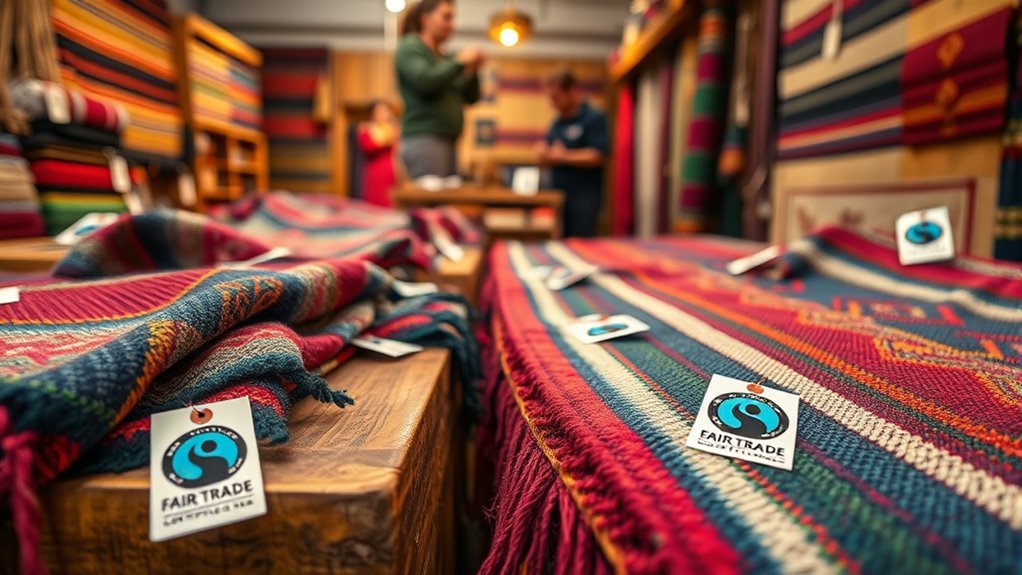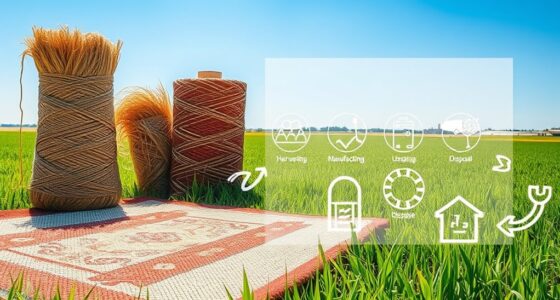To verify fair-trade certifications for ethical weaving, check for recognizable logos from trusted organizations like Fairtrade International or Rainforest Alliance on the product labels. Confirm the certification’s authenticity by visiting official certifier websites or scanning QR codes. Look for transparent supply chain details and clear proof of fair wages and sustainable practices. If you want to learn how to spot genuine claims and avoid counterfeits, keep exploring for more tips.
Key Takeaways
- Look for recognized fair-trade certification marks like Fairtrade International or Rainforest Alliance on woven products.
- Verify certification logos through official certifier websites or apps to confirm authenticity.
- Ensure the supplier provides transparent information about their supply chain and fair wages.
- Check that the product meets environmental sustainability standards and includes detailed origin details.
- Confirm that the certification body is accredited and has recent audits or compliance reports.
Understanding the Principles of Fair Trade

Understanding the principles of fair trade is essential to grasp how it promotes ethical and sustainable practices. At its core, fair trade aims to create a transparent and equitable supply chain where producers, especially farmers, receive fair compensation for their work. This approach empowers farmers by giving them a voice and control over their products, ensuring they benefit directly from their efforts. Fair trade standards emphasize long-term relationships, fair wages, and environmentally sustainable methods. By focusing on transparency and fairness, fair trade helps lift communities out of poverty and encourages responsible farming practices. Incorporating well-draining soil principles ensures that crops are grown sustainably and healthily, supporting fair trade goals. Additionally, understanding the importance of curiosity can motivate consumers and producers alike to seek out more ethical and sustainable options. Recognizing how sound vibrations can influence health and well-being highlights the interconnectedness of sustainable practices and community health. Supporting fair-trade products means endorsing a system that values transparency, fairness, and sustainability, making sure everyone along the supply chain is treated ethically and with respect.
Recognizing Certified Fair-Trade Labels and Logos

When you see a fair-trade label, make sure it features recognizable certification marks that verify its authenticity. Checking the logo’s details helps confirm it’s a genuine certification rather than a counterfeit. By learning to identify trusted logos, you can confidently support fair-trade products. Understanding Fair-Trade Certifications can further aid in distinguishing authentic labels from imitations. Recognizing the various yoga styles and their specific symbols can also help in verifying the authenticity of certified products. Additionally, being aware of electric dirt bike horsepower can help you understand the significance of quality standards in related certifications. Familiarity with certified logos and their specific design elements is essential for verifying credibility. Being familiar with raw food preparation techniques can also support ethical and sustainable sourcing practices.
Recognizable Certification Marks
Recognizable certification marks play a pivotal role in helping consumers identify products that meet fair-trade standards. These labels provide instant assurance of ethical sourcing and a positive fair trade impact. When you see a familiar logo, you can trust that the product supports fair wages, sustainable practices, and community development. Certification marks like Fairtrade International or Rainforest Alliance are designed to stand out, making it easier for you to make informed choices. By choosing items with these marks, you directly contribute to improving working conditions and promoting responsible production. Clear and consistent certification marks help build consumer confidence and encourage brands to uphold high ethical standards, fostering a more sustainable and fair global marketplace. Recognizable certification marks also help consumers understand the standards and criteria behind each label, ensuring transparency and accountability in fair trade practices. These marks often incorporate cultural significance to reflect local traditions and ethical commitments, further strengthening consumer trust. Understanding the certification process and the vetting procedures behind these marks can enhance your confidence in their legitimacy. Additionally, awareness of vetted products ensures that consumers are supporting genuinely ethical and safe practices in fair trade.
Verifying Logo Authenticity
To guarantee that the fair-trade labels you see are genuine, it’s important to verify the authenticity of logos and certification marks. Authentic logos ensure products come from sustainable farming and ethical sourcing practices. Check for official certification symbols on labels and packaging. Make sure the logo matches the official design from recognized certifying organizations. Some labels have unique features like holograms or QR codes for quick verification. Use the certifier’s website or app to verify a logo’s authenticity. Remember, counterfeit logos can appear convincing but lack the credibility of genuine marks. Additionally, understanding certification standards can help you better assess a product’s ethical sourcing. Being aware of cookie policies can also inform you about how your browsing data might be used when researching products online.
Investigating Certification Bodies and Accreditation Processes

To understand fair-trade certifications, you need to examine how certification bodies set their standards and how accreditation processes verify their credibility. You’ll want to learn how these organizations are evaluated and what methods are used to confirm authenticity. This knowledge helps guarantee that the labels you trust truly meet rigorous fair-trade criteria. Additionally, understanding the assessment methods used by these organizations can provide deeper insight into their reliability and integrity.
Certification Body Standards
Ever wondered how certification bodies guarantee the integrity of fair-trade standards? They set rigorous certification body standards to guarantee compliance. These standards require transparent supply chains, so you can trace products from farm to market, confirming ethical practices at each step. Certification bodies also evaluate how producers minimize environmental impact, promoting sustainable agriculture and resource use. They conduct regular audits and verify documentation to prevent false claims and ensure ongoing adherence. By enforcing strict criteria, these bodies uphold credibility and protect consumers from misleading labels. Their standards act as a safeguard, ensuring that fair-trade certifications genuinely reflect ethical sourcing, environmental responsibility, and transparent operations. That way, you can trust that the products you choose meet high ethical and sustainability benchmarks.
Accreditation Procedures Explained
Have you ever wondered how certification bodies earn the authority to grant fair-trade labels? Accreditation bodies evaluate them through strict procedures to guarantee they uphold standards for sustainable sourcing and ethical labor. These procedures involve rigorous audits, document reviews, and on-site inspections to verify compliance. To clarify, here’s a quick overview:
| Accreditation Step | Description |
|---|---|
| Application Submission | Certification body applies for accreditation. |
| Document Review | Accreditation body assesses policies and procedures. |
| On-site Inspection | Verifies implementation of fair-trade standards. |
| Compliance Evaluation | Ensures ongoing adherence to ethical labor practices. |
| Continuous Monitoring | Regular audits maintain accreditation status. |
This process guarantees that certification bodies truly promote fair, sustainable practices in the supply chain.
Verifying Authenticity Methods
Understanding how to verify the authenticity of fair-trade certifications begins with examining the credibility of the certification bodies themselves. You should look into their accreditation processes and how they monitor ethical sourcing throughout the supply chain. To do this effectively, consider these steps:
- Review the certification body’s accreditation status with recognized agencies.
- Investigate their auditing procedures for supply chain transparency.
- Check for recent reports or updates on their compliance and enforcement actions.
These measures ensure that the certification body maintains rigorous standards, confirming that products genuinely meet fair-trade requirements. By understanding these methods, you can confidently verify that the certifications reflect authentic ethical sourcing practices, making your support meaningful and impactful.
Key Indicators of Authentic Fair-Trade Products

Authentic fair-trade products display specific indicators that help you identify their legitimacy. First, look for certification labels from recognized organizations, which verify sustainable sourcing practices. These labels ensure the product comes from suppliers committed to environmentally responsible methods. Additionally, authentic fair-trade items often highlight fair wages and ethical labor conditions, demonstrating respect for workers’ rights. Transparent packaging and detailed product information also signal credibility, showing the company’s dedication to honesty. Be wary of products lacking clear origin details or certification marks, as they may not meet fair-trade standards. By paying attention to these indicators, you can confidently support products that genuinely promote sustainable sourcing and uphold ethical labor practices.
Common Misleading Claims and How to Spot Them

How can you tell if a claim about fair-trade products is misleading? Watch out for greenwashing tactics and confusing marketing jargon that aim to make products seem more ethical than they are. To spot deception, imagine these common tricks:
- Vague terms like “ethically sourced” without certification proof.
- Phrases such as “all-natural” or “sustainable,” which can be meaningless without context.
- Packaging that highlights a single positive aspect while hiding questionable practices elsewhere.
These claims often sound convincing but lack transparency. Companies may use buzzwords to distract you from unethical labor or environmental issues. Always question the specificity of the language and look for independent verification. Being aware of these tactics helps you make honest choices and avoid falling for misleading claims.
Tips for Verifying Fair-Trade Claims Before Purchasing

Before buying fair-trade products, it’s essential to verify the claims made by brands. Start by checking for transparency in their supply chain—know where and how the products are sourced. Brands committed to fair trade often provide detailed information about their suppliers and farming communities. Look for certifications and ask questions if details aren’t clear. Also, consider fair trade pricing; prices should reflect fair wages and sustainable practices, not just low costs. Reliable brands will openly discuss their pricing models and commitment to ethical standards. Avoid products with vague claims or lack of transparency. Doing your homework ensures you support genuinely ethical practices, helping to promote fairness and sustainability throughout the supply chain.
Frequently Asked Questions
How Often Are Fair-Trade Certifications Renewed or Re-Evaluated?
You might wonder how often fair-trade certifications are renewed or re-evaluated. Certification renewal typically occurs annually, but the re-evaluation frequency can vary based on the certifying organization and specific standards. Regular audits ensure ongoing compliance with fair-trade principles. As a consumer, knowing that re-evaluation happens periodically helps you trust that the certification remains valid and that the producer continues to meet ethical standards.
Can Fair-Trade Products Come From Unethical Supply Chains?
You might wonder if fair-trade products can come from unethical supply chains. It’s possible if supply chain transparency isn’t maintained or certification authenticity is in question. Some suppliers may falsely claim fair-trade status, so you should verify certifications carefully. Always look for trusted labels and ask for proof of ethical practices, ensuring the product truly supports fair working conditions and sustainable sourcing.
Are There Regional Differences in Fair-Trade Certification Standards?
Imagine a map where each region shines with its own unique glow—that’s how regional standards can vary in fair-trade certification. You’ll notice certification discrepancies because different regions set diverse thresholds for fairness and environmental practices. These differences mean that what’s certified as fair trade in one area might not meet the same standards elsewhere. So, always check regional standards to truly understand the certification’s integrity and what it guarantees.
How Do Small Artisans Verify Their Fair-Trade Claims?
You can verify your fair-trade claims by focusing on supply chain transparency and artisan verification methods. Small artisans often document their processes, share with certifying bodies, and keep detailed records of their sourcing and production. They may also participate in independent audits or certifications to prove ethical practices. These steps help make sure their claims are credible, build trust with buyers, and demonstrate their commitment to fair trade principles.
What Are Common Signs of Counterfeit Fair-Trade Labels?
When checking for counterfeit labels, you should look for signs like poor print quality, misspellings, or inconsistent logos, which often indicate counterfeit labels. Authentic fair-trade labels usually have clear, professional printing and secure features, making counterfeit detection easier. Be cautious if the label seems flimsy or if the certification details aren’t verifiable online. Recognizing these signs helps guarantee you’re supporting genuine fair-trade products and not counterfeit labels.
Conclusion
Now that you know what fair trade stands for, don’t just trust any label you see. Think of it like choosing fresh fruit—look beyond the bright packaging to guarantee it’s truly quality. By verifying certifications and understanding the process, you protect workers and the environment. Because, in a world full of tempting claims, being a savvy shopper means blending your passion for ethics with a keen eye—making fair trade more than just a logo, but a genuine choice.









